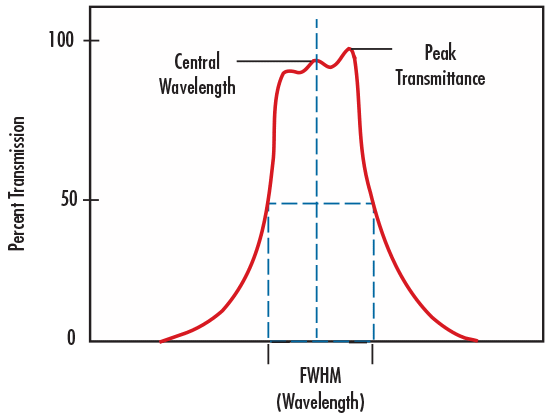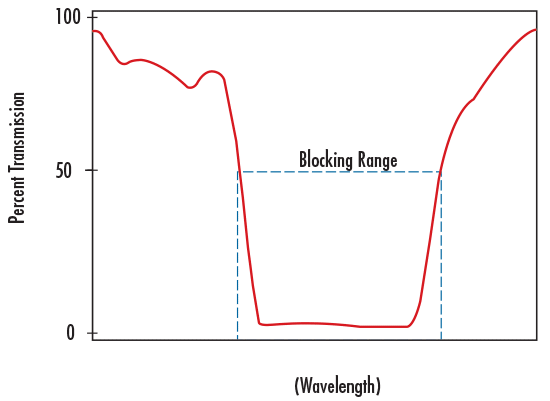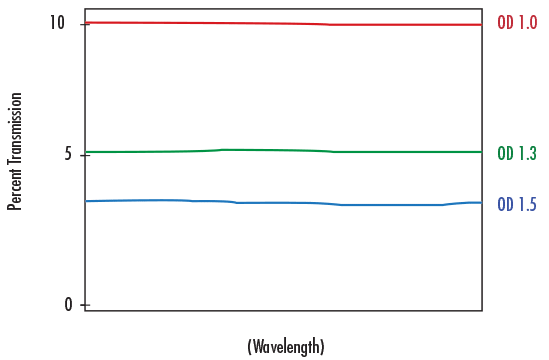Optical filters play a crucial role across a wide range of industries, from scientific research to medical imaging and industrial applications. Their performance is primarily measured by several key metrics, each contributing to the filter's effectiveness in controlling spectral transmission and blocking unwanted wavelengths.
Central Wavelength (CWL): The Heart of Transmission
The central wavelength (CWL) is a core parameter for bandpass filters, marking the midpoint of the spectral bandwidth where the filter's transmission energy is concentrated. Traditional optical filters achieve peak transmission near the CWL, showcasing excellent performance. However, filters coated with hard-coated films offer a unique advantage: a flat transmission profile across the spectral bandwidth, providing more stable light transmission performance for specific applications.

Bandwidth and FWHM: Defining Spectral Range
Bandwidth, also known as Full Width at Half Maximum (FWHM), defines the specific wavelength range within which the filter allows energy to pass through. As shown in Figure as follows, FWHM clearly outlines the filter's transmission characteristics within a given wavelength interval.

FWHM is a critical property for bandpass filters, as it precisely defines the spectral bandwidth that the filter will transmit. The upper and lower limits of FWHM are determined at the wavelengths where the filter's transmission reaches 50% of its maximum. For instance, if the filter's maximum transmission is 90%, the wavelengths corresponding to 45% transmission define the FWHM's upper and lower limits.
Narrowband Filters (FWHM ≤ 10 nm): Widely used in laser purification and chemical detection, these filters offer high selectivity, enabling precise capture and analysis of specific wavelengths.
Mid-Band Filters (FWHM 25–50 nm): Ideal for machine vision applications, these filters balance spectral selectivity with sufficient light throughput, ensuring high image quality and detection accuracy.
Broadband Filters (FWHM > 50 nm): Commonly used in fluorescence microscopy, these filters adapt to complex fluorescence signals, providing comprehensive spectral information for advanced research on biological samples.
Cutoff Range and Optical Density (OD): Selective Blocking
The cutoff range identifies the wavelength interval where the filter attenuates incoming energy, effectively blocking specific wavelengths. As illustrated in Figure as follows, this range enables selective spectral filtering. The degree of blocking is expressed in Optical Density (OD), where higher OD values indicate stronger blocking (lower transmission), and lower OD values suggest weaker blocking (higher transmission).

High OD (≥ 6.0): Suitable for extreme blocking requirements, such as Raman spectroscopy and fluorescence microscopy, ensuring high spectral purity and signal accuracy.
Mid-Range OD (3.0–4.0): Ideal for laser separation, machine vision, and chemical detection, balancing spectral selectivity with adequate light throughput.
Low OD (≤ 2.0): Used in color sorting and spectral separation applications, offering broad spectral coverage for color identification and analysis.
The slope is a critical specification for edge filters, such as shortwave-pass or longwave-pass filters. It describes the transition from high blocking to high transmission within a specific bandwidth. Slope can be flexibly defined based on application needs, often expressed as a percentage of the cutoff wavelength.
For example, a 500 nm longwave-pass filter with a 1% slope would transition from 10% to 80% transmission over a 5 nm (1% of 500 nm) bandwidth. This precise slope control is essential for edge filters, determining their spectral switching capabilities and overall performance in optical systems.
Optical filters rely on key metrics such as central wavelength, bandwidth, FWHM, cutoff range, slope, and optical density to optimize performance across various applications. By understanding and leveraging these parameters, engineers and researchers can design filters that meet the unique requirements of their specific use cases, driving advancements in fields ranging from medical imaging to scientific research and industrial automation.